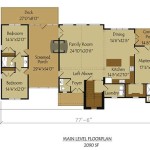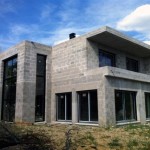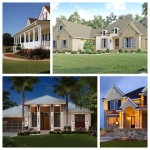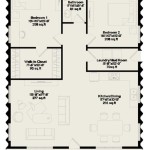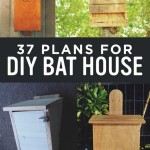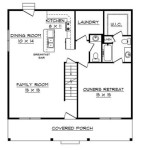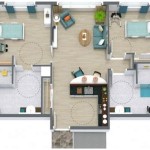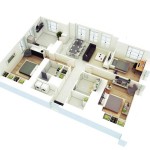Mid-Century House Plans are architectural blueprints designed for residential construction during the mid-20th century, typically from the 1940s to the 1960s. These plans embody the distinctive design principles and living styles prevalent during that era, characterized by an emphasis on simplicity, functionality, and integration with the natural surroundings. A notable example is the iconic Case Study House #22 designed by architect Pierre Koenig, which showcases a light-filled open floor plan, floor-to-ceiling windows, and a seamless connection to the outdoor living space.
Mid-Century House Plans embrace a modernist aesthetic, often featuring flat roofs, asymmetrical forms, and horizontal lines. They emphasize natural light and outdoor connectivity through large windows, sliding glass doors, and vaulted ceilings. The floor plans prioritize fluid movement and open living spaces, with kitchens seamlessly flowing into dining and living areas. These houses also incorporate sustainable design elements, such as passive solar heating and passive ventilation, reflecting the growing awareness of environmental consciousness during that period.
In this article, we will delve deeper into the defining characteristics of Mid-Century House Plans, exploring their historical context, design principles, and their enduring influence on contemporary architecture.
Mid-Century House Plans are characterized by several key features that define their unique architectural style:
- Flat roofs
- Asymmetrical forms
- Horizontal lines
- Large windows
- Open floor plans
- Passive solar heating
- Passive ventilation
- Integration with nature
These elements combine to create houses that are not only visually striking but also highly functional and environmentally conscious.
Flat roofs
Flat roofs are a defining characteristic of Mid-Century House Plans. They create a clean, modern aesthetic and contribute to the home’s overall simplicity and functionality.
- Clean lines and simplicity: Flat roofs eliminate the complex rooflines and dormers found in traditional houses. This creates a sleek, uncluttered look that is synonymous with Mid-Century Modern architecture.
- Increased usable space: Flat roofs provide additional usable space that can be used for outdoor living, gardening, or recreation. This is especially valuable in urban areas where space is limited.
- Energy efficiency: Flat roofs can be more energy-efficient than pitched roofs. They provide a larger surface area for installing solar panels and can be insulated more effectively to reduce heat loss.
- Low maintenance: Flat roofs require less maintenance than pitched roofs. They are easier to inspect, repair, and replace, which can save homeowners time and money in the long run.
Flat roofs are not without their drawbacks. They can be more susceptible to leaks than pitched roofs, and they may require more frequent maintenance in areas with heavy rainfall or snowfall. However, with proper design and construction, flat roofs can be a durable and stylish addition to any Mid-Century House Plan.
Asymmetrical forms
Asymmetry is a key characteristic of Mid-Century House Plans. It refers to the deliberate use of unbalanced or mismatched elements in the design of a building. This creates a visually dynamic and interesting space that breaks away from the traditional symmetry of classical architecture.
Asymmetrical forms can be achieved in a variety of ways, such as using different window sizes and shapes, varying rooflines, or offsetting the placement of doors and windows. This creates a sense of movement and energy that is characteristic of Mid-Century Modern architecture.
Asymmetry can also be used to create a focal point in a room or to draw attention to a particular feature. For example, a large picture window or a dramatic fireplace can be placed off-center to create a visual impact.
Asymmetrical forms can also be used to create a more organic and natural feel in a home. By mimicking the asymmetry found in nature, architects can create houses that feel more connected to the environment.
Overall, asymmetrical forms are a key part of the Mid-Century Modern aesthetic. They create visually interesting and dynamic spaces that break away from traditional symmetry. When used effectively, asymmetry can create a home that is both stylish and inviting.
Horizontal lines
Horizontal lines are a defining characteristic of Mid-Century House Plans. They create a sense of length, width, and openness, which is characteristic of the Mid-Century Modern style.
- Emphasis on horizontality: Horizontal lines emphasize the horizontal plane, creating a sense of stability and groundedness. This is in contrast to traditional architecture, which often emphasizes verticality.
- Connection to the landscape: Horizontal lines create a visual connection between the house and the surrounding landscape. This is especially important in Mid-Century House Plans, which often feature large windows and open floor plans that blur the boundaries between indoor and outdoor space.
- Simplicity and elegance: Horizontal lines create a simple and elegant look that is characteristic of Mid-Century Modern architecture. They avoid the ornamentation and fussiness of traditional styles, creating a clean and uncluttered aesthetic.
- Expansion of space: Horizontal lines can make a space feel larger and more spacious. This is especially important in smaller homes, where every square foot counts.
Overall, horizontal lines are a key part of the Mid-Century Modern aesthetic. They create a sense of length, width, and openness, which is characteristic of the style. When used effectively, horizontal lines can create a home that is both stylish and inviting.
Large windows
Large windows are a defining characteristic of Mid-Century House Plans. They allow for natural light to flood into the home, creating a bright and airy atmosphere. Large windows also provide expansive views of the surrounding landscape, blurring the boundaries between indoor and outdoor space.
The use of large windows in Mid-Century House Plans is a reflection of thelifestyle. People were increasingly spending time outdoors, and they wanted their homes to reflect this connection to nature. Large windows allowed them to enjoy the outdoors from the comfort of their own homes.
In addition to their aesthetic and lifestyle benefits, large windows also have practical advantages. They allow for natural light to heat the home in the winter, reducing energy costs. Large windows can also help to improve air quality by providing natural ventilation.
Overall, large windows are a key part of the Mid-Century Modern aesthetic. They create bright, airy, and inviting spaces that are connected to the outdoors. When used effectively, large windows can create a home that is both stylish and sustainable.
Here are some additional details about the use of large windows in Mid-Century House Plans:
- Placement: Large windows are often placed on the south side of the house to take advantage of natural light. They may also be placed on the east or west side of the house to provide views of the sunrise or sunset.
- Size and shape: Large windows can vary in size and shape. They may be full-height windows, floor-to-ceiling windows, or even corner windows. The size and shape of the windows will depend on the design of the house and the surrounding landscape.
- Materials: Large windows are typically made of glass or aluminum. Glass windows are more traditional, while aluminum windows are more modern. The choice of material will depend on the desired aesthetic and budget.
Open floor plans
Open floor plans are a defining characteristic of Mid-Century House Plans. They create a spacious and airy atmosphere by eliminating walls and other barriers between different living areas. This allows for natural light to flow throughout the home and creates a sense of flow and movement.
Open floor plans are often used in conjunction with large windows to further enhance the feeling of spaciousness and connection to the outdoors. This creates a bright and inviting living space that is perfect for entertaining guests or simply relaxing with family.
In addition to their aesthetic benefits, open floor plans also have practical advantages. They allow for more efficient use of space, making them ideal for smaller homes. Open floor plans also make it easier to supervise children and pets, and they can promote a sense of community and togetherness among family members.
Overall, open floor plans are a key part of the Mid-Century Modern aesthetic. They create spacious, airy, and inviting spaces that are perfect for modern living. When used effectively, open floor plans can create a home that is both stylish and functional.
Here are some additional details about open floor plans in Mid-Century House Plans:
- Layout: Open floor plans typically have a central living area that is flanked by the kitchen, dining room, and other living spaces. This creates a sense of flow and movement that is characteristic of Mid-Century Modern architecture.
- Flexibility: Open floor plans are flexible and can be easily adapted to different needs and lifestyles. For example, a family with young children may use the open floor plan to create a play area, while an empty nester may use the space for a home office or library.
- Privacy: While open floor plans create a sense of spaciousness and togetherness, they can also lack privacy. To address this, some Mid-Century House Plans include sliding doors or screens that can be used to separate different living areas when needed.
Passive solar heating
Passive solar heating is a design strategy that uses the sun’s energy to heat a building without the use of active mechanical systems, such as furnaces or boilers. This is achieved through the use of large windows, thermal mass, and proper insulation.
Large windows allow sunlight to enter the building, which is then absorbed by thermal mass, such as concrete or brick. This thermal mass stores the heat and releases it slowly over time, helping to maintain a comfortable indoor temperature. Proper insulation helps to trap the heat inside the building, preventing it from escaping.
Passive solar heating is a very efficient way to heat a home, as it does not require the use of any additional energy sources. It is also a very comfortable way to heat a home, as it provides a gentle and even heat that is not too hot or too cold.
There are many different ways to incorporate passive solar heating into a Mid-Century House Plan. Some common strategies include:
- South-facing windows: Placing large windows on the south side of the house allows sunlight to enter the building throughout the day.
- Thermal mass: Using materials with a high thermal mass, such as concrete or brick, helps to store heat and release it slowly over time.
- Insulation: Proper insulation helps to trap heat inside the building, preventing it from escaping.
- Overhangs: Overhangs can be used to shade windows during the summer months, preventing the building from overheating. However, they should be designed to allow sunlight to enter the building during the winter months.
Passive solar heating is a great way to reduce energy costs and create a more comfortable living environment. When used effectively, passive solar heating can help to create a home that is both stylish and sustainable.
Passive ventilation
Passive ventilation is a design strategy that uses natural forces, such as wind and buoyancy, to ventilate a building without the use of active mechanical systems, such as fans or air conditioners. This is achieved through the use of strategically placed windows, vents, and other openings.
Passive ventilation works by creating a pressure difference between different parts of a building. This pressure difference causes air to flow from areas of high pressure to areas of low pressure. In the summer, warm air rises and exits through high vents, while cooler air is drawn in through low vents. In the winter, the opposite occurs, with warm air being drawn in through low vents and cooler air exiting through high vents.
Passive ventilation is a very efficient way to ventilate a building, as it does not require the use of any additional energy sources. It is also a very comfortable way to ventilate a building, as it provides a gentle and even flow of fresh air.
There are many different ways to incorporate passive ventilation into a Mid-Century House Plan. Some common strategies include:
- Cross-ventilation: Cross-ventilation is achieved by placing windows and vents on opposite sides of a room. This allows air to flow freely through the room, creating a cooling breeze.
- Stack ventilation: Stack ventilation is achieved by placing vents at different heights on a building. This creates a pressure difference that causes air to flow from the lower vents to the higher vents.
- Wind scoops: Wind scoops are devices that are placed on the roof of a building to catch the wind and direct it into the building. This can help to increase ventilation rates.
- Solar chimneys: Solar chimneys are devices that use the sun’s energy to create a flow of air. They are typically placed on the roof of a building and consist of a dark-colored chimney that is heated by the sun. The heated air rises through the chimney, creating a suction that draws air into the building.
Passive ventilation is a great way to reduce energy costs and create a more comfortable living environment. When used effectively, passive ventilation can help to create a home that is both stylish and sustainable.
Integration with nature
Mid-Century House Plans are designed to seamlessly integrate with the surrounding natural environment. This is achieved through the use of natural materials, large windows, and open floor plans that create a connection between the indoors and outdoors.
- Use of natural materials: Mid-Century House Plans often use natural materials, such as wood, stone, and brick, to create a warm and inviting atmosphere. These materials also help to connect the house to the surrounding landscape.
- Large windows: Large windows are a defining characteristic of Mid-Century House Plans. They allow for natural light to flood into the home, creating a bright and airy atmosphere. Large windows also provide expansive views of the surrounding landscape, blurring the boundaries between indoor and outdoor space.
- Open floor plans: Open floor plans create a spacious and airy atmosphere by eliminating walls and other barriers between different living areas. This allows for natural light to flow throughout the home and creates a sense of flow and movement. Open floor plans also make it easier to connect with the outdoors, as they often feature large windows and doors that lead to patios, decks, and gardens.
- Outdoor living spaces: Mid-Century House Plans often include outdoor living spaces, such as patios, decks, and gardens. These spaces provide a place to relax and enjoy the outdoors, and they also help to extend the living space of the home.
Overall, the integration with nature is a key part of the Mid-Century Modern aesthetic. It creates homes that are both stylish and sustainable, and that offer a close connection to the outdoors.










Related Posts

